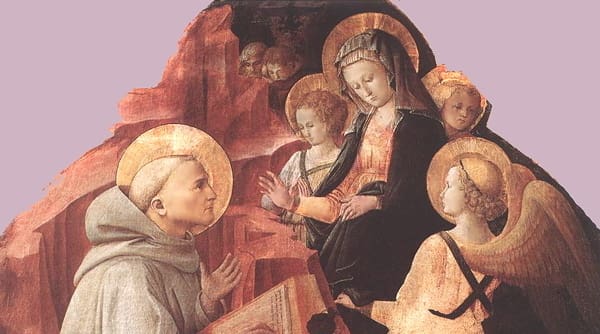Editor’s Note: David Torkington continues his series with a segue into the history of Christian Mystical Tradition, looking now at the beginnings of the monastic life and its influence in the Christian culture. To read part 30, see here. To begin with part 1, see here.
A Brief History of Christian Mystical Spirituality, Continued.
The history of Christian spirituality is rather like a roller coaster with continual ups and downs, as renewal is followed by decline as the human spirit inevitably falters and falls despite best efforts. When monks who had attained ‘spiritual paternity’ led renewal all was well, but sadly when their fervor faded, or when monks who were spiritually unprepared for the task went out into the world, it was the world that converted them to its own ways and its own standard of living the ‘good life’. So by the eighth century, Europe was awash with wandering monks, busily undoing by their behavior all that was done by their illustrious forebears.
Charlemagne’s Monastic reforms
The situation was such a scandal that when Charlemagne was enthroned in AD 800 he ordered all monks back to their monasteries and decreed that henceforth all monasteries in his empire must accept and observe the rule of St. Benedict. The vow of stability taken by every monk meant that the monasteries would never be able to provide Christendom with itinerant preachers as in the past. Cluniac, Cistercian and Carthusian monks would help reinterpret and reform the monastic life in subsequent centuries, but they would do little for the laity who were increasingly starved of evangelical spirituality.
The Canons Regular who initially developed out of monastic life had little effect as the diluted form of monastic spirituality on which they depended was hardly sufficient to keep them from spiritual starvation themselves, let alone enable them to feed those starving in the world. It was certainly not sufficient to generate with any consistency the profound contemplative prayer that animates the effective apostle.
If genuine and far-reaching renewal was necessary for the Church to lead its people back to its God-given spirituality, two things would be necessary. Firstly, Christ should be repositioned back into the center of Christian spirituality. This must be done in such a way that people could once more come to know and love him in his human nature and so be taken up into his divine nature, to contemplate the Father. Secondly, this new presentation of the old spirituality would then have to be taken into the secular world, to the ordinary people, by a new brand of religious who first practiced what they were to preach to others. All this was about to start at the beginning of the twelfth century.
The Famous Knock on the Door
Sometimes in human history, you feel that drums should roll, cymbals clash, trumpets sound, and spotlights should highlight a particularly important event or person, or both. Just such a time had come in the year AD 1112. The place where this event was about to happen was at a newly-found monastery at Citeaux in France. The English Abbot Stephen Harding was on the verge of giving up the new venture to go back to the early Benedictine tradition in all its rigor and simplicity with the emphasis on daily manual labor in the fields when there was a knock on the monastery door.
When the door was opened it was to reveal St. Bernard, a young nobleman of 23 years of age with thirteen of his friends. Like the first apostles, they were drunk with spiritual fervor. But they were not yet ready to go out to the world to fill it with what filled them; they needed to enter into solitude for their charismatic enthusiasm to be tempered through purification in the mystic way.
The First Crusade
They had been set alight by the latest religious fashion that was consuming medieval Europe. In 1095 Pope Urban ll inaugurated the first Crusade. Less than ten years later pilgrims who had been to the Holy Land on pilgrimage came flooding back, inspired and animated with what they had seen. They saw where Jesus was born, where he grew up, where he preached, where he worked miracles, and where he suffered and died before rising from the dead and ascending into heaven to send the Holy Spirit.
Once Jesus in his loving and loveable human nature was back center stage at the heart of Christianity, the faithful could come to love him, and enter into him and his mystical body. At the beginning of this new age, St. Bernard was the first to follow his heart into the mystic way that would enable him to develop a new Christ-centred theology and mystical spirituality that would be the cornerstone of Christian spirituality for centuries to come. Only three years after he joined this new Cistercian reform he was sent to found another monastery at Clairvaux in 1115 where he was Abbot until his death in 1153. In his monumental study of Christian spirituality, Père Pourrat devotes nearly one hundred pages to St Bernard, showing his ‘emphasis above all on devotion to the mysteries of Our Lord’s Life – the infancy, the episodes of the Passion and the Crucifixion and also his devotion to the Blessed Virgin’. In the view of Pourrat, it is above all St. Bernard who shaped the theology of the later Middle Ages and also of modern times.
St. Bernard’s Mystical Theology
His mystical theology was particularly innovative. In the very early Church, it was known and accepted that virgins were seen as brides of Christ. Many of the early Fathers commentated on the Song of Solomon to develop the idea that the Church is the bride of Christ. Even individuals in their personal spiritual search were sometimes referred to as bride’s of Christ, but St. Bernard went further. In his famous commentaries on this deeply moving and romantic poem he goes a step further, and then continually embellishes his theme in some of the most lyrical language used so far to depict a mystic’s relationship with Christ.
The theme is that it is in the act of mystical contemplation itself that the mystic becomes in a very real and experiential way a bride of Christ. Furthermore, it is in the blossoming of this intimate bridal relationship that a person comes to the consummation of the spiritual life, the ‘Spiritual Marriage’. This same theme would be taken up by the great Scottish mystic Richard of St. Victor (1110-1173) who had become the influential prior of the Canons Regular of St. Augustine of St. Victor in Paris. Thereafter, the idea that ‘The Mystical’ or the ‘Spiritual Marriage’ represented the summit of the mystic way became generally accepted. It featured in the bridal mysticism of the Rhineland mystics, then John Ruysbroeck and of course St. John of the Cross and St. Teresa of Avila. Through these latter two it has come to be the accepted way of referring to the summit of the mystic way.
The Limitations of the Vow of Stability
Although the theological and mystical writings of St. Bernard had an immediate effect on his monastic contemporaries, theologians and open-minded Bishops and their clergy, it was someone else who was destined to take this new Christ-centered spirituality to ordinary people. For St. Bernard and the new members of the Cistercian order, their spirituality was more than adequate to lead them to the heights of the mystic way, but their vow of stability still prevented them from taking their new-found Christ-centered spirituality to the world that was in such need. In the years after Bernard’s death more and more little bands of fervent men, some of whom had been on pilgrimage to the Holy Land, dedicated themselves to living more evangelical lives and then preaching to others to do likewise.
That the renewal they were trying to bring about was necessary was beyond doubt, for the long and depressive spiritual emptiness of the ‘Dark Ages’ had taken its toll on the moral fiber of a Church lacking the inner mystical life that was about to reanimate it. The text of the Fourth Lateran Council (1215) that was now on the horizon painted a gloomy picture of the woes of clerical irregularities that it was called to remedy. However, it had already been decided that the many groups of evangelical men who had set themselves up to renew the Church were not fit for purpose. With the best will in the world, they had become ‘evangelical ranters’ full of bile and vitriol for the clergy who may well have deserved their invective but it would never convert them, for only the humble can speak to the dissolute and the depraved with any hope of being heard.
From Monks to Mendicants
The man who would do what they failed to do was born thirty years after St. Bernard. He not only fed off the fervor of others who had been to the Holy places but actually went there himself. His name was St. Francis of Assisi.
Unlike St. Bernard, he was called to take the new spirituality to ordinary people like himself, founding a new religious order that enabled him to do this on a grand scale. Other mendicant orders began to flourish with the Franciscans, all trying in their own way to respond to the needs of a Christendom which had been sliding back into paganism. The Franciscans originally grew out of a lay movement, the Carmelites from the eremitical life, and the Dominicans owed much to the monastic life that they adapted for the sake of those spiritually languishing in the world.
It was at the Fourth Lateran Council that these new Orders were encouraged to bring about the reform in the Church that was so long overdue with the new spirituality developed by St. Bernard. These Orders were teeming with saintly men and women who are still household names today: St. Francis of Assisi, St. Anthony of Padua, St. Bonaventure, St. Dominic, St. Albert the Great, St. Thomas Aquinas, St. Clare, St. Margaret of Cortona, St. Angela of Foligno and so many others canonized for their transparent and heroic holiness.
When seeing what seemed to be a freedom denied them by their vow of stability some members of monastic orders began to criticize these new orders suggesting that their place should be in the monastery, not gadding about in the world. It was St. Thomas Aquinas who answered them with the words that I have already used to describe the essence of early Christian spirituality. ‘Our apostolate,’ he insisted, ‘is to contemplate and then to share the fruits of contemplation with others’.
The Virgin Appears to St Bernard by Filippo Lippi, Wikimedia Commons.





